#Pennsylvanian fossil
Explore tagged Tumblr posts
Photo

Alethopteris Fossil Leaf Fern – Carboniferous Coal Measures – Radstock, Somerset, UK – Authentic Plant Fossil
Authentic Alethopteris Fossil Leaf Fern – Carboniferous Coal Measures – Radstock, Somerset, UK
This listing features a beautifully preserved fossilised leaf of Alethopteris, a type of seed fern (Pteridospermatophyta) common in Carboniferous coal swamps. This specimen was excavated from the historic Coal Measures strata in Radstock, Somerset, and dates to the Late Carboniferous Period (Pennsylvanian Subsystem), approximately 310 million years ago.
Geological & Palaeobotanical Details:
Fossil Genus: Alethopteris
Family: Alethopteridaceae
Order: Medullosales
Class: Pteridospermatophyta (Seed Ferns)
Geological Age: Carboniferous (Pennsylvanian)
Formation: British Upper Coal Measures
Depositional Environment: Moist, equatorial deltaic swamp with fluctuating water levels – a habitat ideal for dense vegetation and coal formation
Location: Radstock Coalfield, Somerset, United Kingdom
Morphological Features:
Distinctive bipinnate fronds with symmetrical leaflets (pinnae)
Prominent midribs and lateral venation typical of seed ferns
Leaves believed to belong to seed-bearing plants, now extinct
Biozone (if assigned): Typically associated with Lenisulcata or Gastrioceras ammonoid zones regionally
Fossil Identification: Described and classified in the 19th century; remains a key taxon in palaeobotany due to its prevalence and role in coal formation
Specimen Notes:
Discovered by: UKGE team members Alister and Alison
Discovery Date: 06 March 2025
Preparation: Cleaned, stabilised, and prepped by Alison
Condition: Well-defined fossil on natural matrix, showing clear detail of fossilised leaf structure
Photography: Scale cube = 1cm. Photos show actual specimen – what you see is what you will receive
Authenticity: Comes with Certificate of Authenticity – all fossils sold by us are genuine and responsibly sourced
Why Choose Alethopteris?
Alethopteris is not only a stunning example of Carboniferous flora but also a tangible link to the lush tropical landscapes that once dominated Europe. Its role in forming the vast coal beds of the UK makes it both a beautiful and historically significant specimen for collectors, educators, or as a natural history display.
Secure a genuine piece of Earth’s botanical past today with this expertly sourced and prepared fossil fern.
#Alethopteris fossil#fossil fern#Carboniferous plant fossil#Coal Measures#Radstock fossil#Somerset fossil#UK fossil plant#genuine fern fossil#Alethopterid leaf#palaeobotany#fossil foliage#Pennsylvanian fossil#authentic fossil leaf#seed fern fossil
0 notes
Text
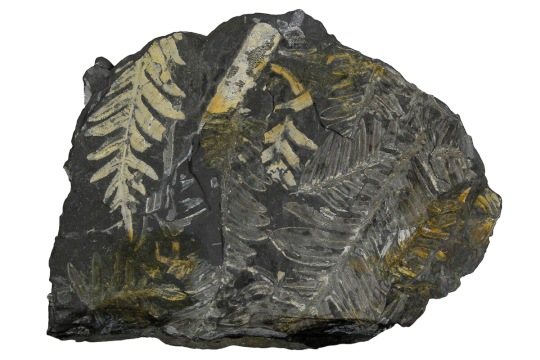

6.3" Fossil Seed Fern (Alethopteris) Plate - Pennsylvania
#Pennsylvanian#alethopteris#fossil seed fern#fossil fern#fern fossil#seed fern#fossil plate#plant fossil#plant#fossil#fossils#paleoblr#png#transparent#paleontology#prehistoric#ferns
92 notes
·
View notes
Text

A Guide to Pennsylvanian (Carboniferous) Age Plant Fossils of Southwest Virginia by Thomas F. Mcloughlin
Thomas F. Mcloughlin delves into the rich fossilized landscapes of Southwest Virginia in "A Guide to Pennsylvanian (Carboniferous) Age Plant Fossils of Southwest Virginia." Featuring over 280 vivid illustrations, this book about fossil plants of Southwest Virginia serves as a visual feast, providing a virtual roadmap through the fascinating realm of the fossilized flora of Southwest Virginia.
Embrace the wonders of ancient plant life. Grab a copy at www.tfmcloughlin.com.
#Thomas F. McLoughlin#Atlas of Pennsylvanian Age Fossils#ReadersMagnet#atlas#prehistoric plant life#marine organisms#Plant Fossils#Fossil Collectors#Amateur Paleontology#Paleobotany#Geology#Natural History
0 notes
Text
Here's a selection of other fossils I've found over my last few trips to this site:


Asterophyllites, a form genus for the foliage of Calamites.


Fronds of Neuropteris.

A charcuterie board of Macroneuropteris and Pecopteris.

Macroneuropteris frond (I normally find them as individual leaves!)


A Macroneuropteris leaf that has oxidized in a way that turned it iridescent like an oil slick.


My pride and joy... This huge Pecopteris frond!
There are many more, I might post some of them at some point.
I returned to a Pennsylvanian (late Carboniferous) site I had visited a few times and I finally found some Sphenophyllum!


#paleobiology#paleontology#paleoblr#paleobotany#geoscience#geology#plants#evolution#carboniferous#pennsylvanian#horsetail#Sphenophyllum#Calamites#Asterophyllites#medullosan#seed fern#Neuropteris#Macroneuropteris#fern#tree fern#Pecopteris#fossils
44 notes
·
View notes
Text

The distinctive pinhole eyes, leathery hood, and numerous tentacles of modern nautiluses were traditionally thought to represent the "primitive" ancestral state of early shelled cephalopods – but genetic studies have found that that nautiluses actually secondarily lost the genes for building lensed eyes, and their embryological development shows the initial formation of ten arm buds (similar to those of coeloids) with their hood appearing to be created via fusing some of the many tentacles that form later.
There's a Cretaceous nautilidan fossil that preserves soft tissue impressions of what appear to be pinhole eyes and possibly a remnant of a hood, so we know these modern-style nautilus features were well-established by the late Mesozoic. But for much more ancient Paleozoic members of the lineage… we can potentially get more speculative.
So, here's an example reconstructed with un-nautilus-like soft parts.
Solenochilus springeri was a nautilidan that lived during the Late Carboniferous, around 320 million years ago, in shallow tropical marine waters covering what is now Arkansas, USA.
Up to about 20cm in diameter, (~8"), its shell featured long sideways spines which may have served as a defense against predators – or possibly as a display feature since they only developed upon reaching maturity.
———
NixIllustration.com | Tumblr | Patreon
References:
Anthony, Franz. "500 million years of cephalopod fossils" Earth Archives, 19 Feb. 2018, https://eartharchives.org/articles/500-million-years-of-cephalopod-fossils/index.html
Klug, Christian, et al. "Preservation of nautilid soft parts inside and outside the conch interpreted as central nervous system, eyes, and renal concrements from the Lebanese Cenomanian." Swiss Journal of Palaeontology 140 (2021): 1-11. https://doi.org/10.1186/s13358-021-00229-9
Korn, Dieter, and Christian Klug. "Early Carboniferous coiled nautiloids from the Anti-Atlas (Morocco)." European Journal of Taxonomy 885 (2023): 156-194. https://doi.org/10.5852/ejt.2023.885.2199
Kröger, Björn, Jakob Vinther, and Dirk Fuchs. "Cephalopod origin and evolution: a congruent picture emerging from fossils, development and molecules: extant cephalopods are younger than previously realised and were under major selection to become agile, shell‐less predators." BioEssays 33.8 (2011): 602-613. https://doi.org/10.1002/bies.201100001
Mikesh, David L., and Brian F. Glenister. "Solenochilus Springeri (White & St. John, 1868) from the Pennsylvanian of Southern Iowa." Proceedings of the Iowa Academy of Science. Vol. 73. No. 1. 1966. https://scholarworks.uni.edu/pias/vol73/iss1/39/
Shchedukhin, A. Yu. "New Species of the Genus Acanthonautilus (Solenochilidae, Nautilida) from the Early Permian Shakhtau Reef (Cis-Urals)." Paleontological Journal 58.5 (2024): 506-515. https://www.researchgate.net/publication/384922837_New_Species_of_the_Genus_Acanthonautilus_Solenochilidae_Nautilida_from_the_Early_Permian_Shakhtau_Reef_Cis-Urals
Wikipedia contributors. “Nautilida” Wikipedia, 26 Nov. 2024, https://en.wikipedia.org/wiki/Nautilida
Wikipedia contributors. “Solenochilus” Wikipedia, 28 Apr. 2022, https://en.wikipedia.org/wiki/Solenochilus
#science illustration#paleontology#paleoart#palaeoblr#solenochilus#solenochilidae#nautilida#nautiloid#cephalopod#mollusc#invertebrate#art#doing the inverse of all those ammonite reconstructions that make them look like nautiluses
220 notes
·
View notes
Text

Amazing Neuropteris (seed fern) Fossil with Exceptional Preservation From Grundy County, Illinois. Age: Pennsylvanian (~300 m.y.a.).
Photo 📷 juarezfossil/IG
189 notes
·
View notes
Text

Big news for hagfish fans!!
references
Bardack, D. (1991). First Fossil Hagfish (Myxinoidea): A Record from the Pennsylvanian of Illinois. Science, 254(5032), 701–703. https://doi.org/10.1126/SCIENCE.254.5032.701
Fernholm, B., & Mincarone, M. M. (2023). A new species of the hagfish genus Eptatretus (Myxinidae) from the Bahamas, western North Atlantic. Journal of Fish Biology, 102(4), 962–967. https://doi.org/10.1111/JFB.15343
Fudge, D. S., Levy, N., Chiu, S., & Gosline, J. M. (2005). Composition, morphology and mechanics of hagfish slime. Journal of Experimental Biology, 208(24), 4613–4625. https://doi.org/10.1242/JEB.01963
Hirasawa, T., Oisi, Y., & Kuratani, S. (2016). Palaeospondylus as a primitive hagfish. https://doi.org/10.1186/s40851-016-0057-0
Miyashita, T., Coates, M. I., Farrar, R., Larson, P., Manning, P. L., Wogelius, R. A., Edwards, N. P., Anné, J., Bergmann, U., Richard Palmer, A., & Currie, P. J. (2019). Hagfish from the Cretaceous Tethys Sea and a reconciliation of the morphological-molecular conflict in early vertebrate phylogeny. Proceedings of the National Academy of Sciences of the United States of America, 116(6), 2146–2151. https://doi.org/10.1073/PNAS.1814794116/-/DCSUPPLEMENTAL
Parasramka, V. (2023). Manufacturing synthetic Hagfish slime skeins using embedded 3D printing. https://hdl.handle.net/2142/120467
Siu, R. (2023). Additive manufacturing methods for fabricating synthetic Hagfish skeins. https://hdl.handle.net/2142/120593
Zintzen, V., Roberts, C. D., Anderson, M. J., Stewart, A. L., Struthers, C. D., & Harvey, E. S. (2011). Hagfish predatory behaviour and slime defence mechanism. Scientific Reports 2011 1:1, 1(1), 1–6. https://doi.org/10.1038/srep00131
#will be reposting this on hagfish birthday#hagfish#eddie infodumps#eddie in the ocean#marine biology
64 notes
·
View notes
Text
Fossil Friday: Paleothyris arcadiana
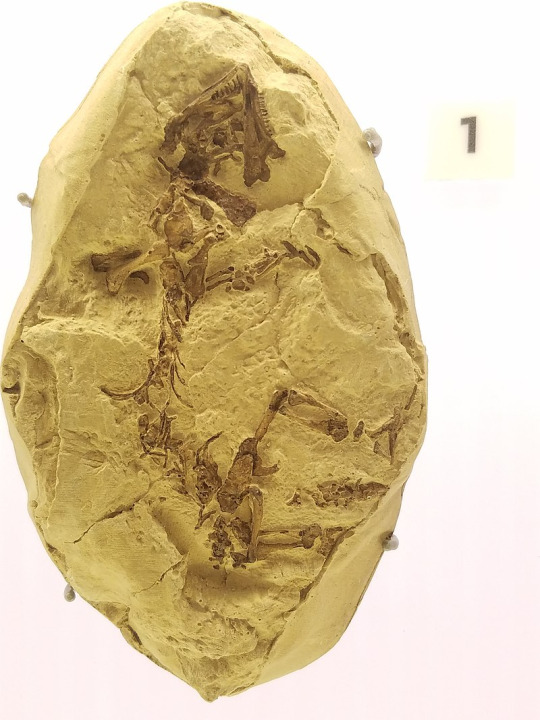
This is Paleothyris arcadiana. It is a small reptile from Late Pennsylvanian rocks of Nova Scotia. It is younger than Hylonomus but more basal. This means that, phylogenetically speaking, it is closer to the ancestral state than Hylonomus is.
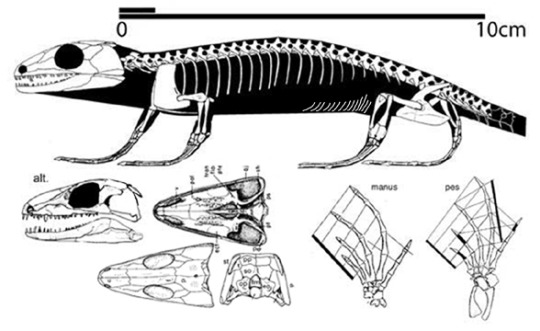
Paleothyris had long fingers and toes which would provide more agility and climbing abilities in it's forest home. It was about the same size as Hylonomus and probably filled a similar niche, eating insects. It's large eyes suggest that it was likely nocturnal as well. It still retains the ancestral anapsid skull (no temporal fenestrae).
26 notes
·
View notes
Text
Psst... Ya like trees?
Happy Carboniferous Week!
If the Earth's history were compressed into a single year, December 3rd - 7th marks the Carboniferous period (358.9-298.9 Mya).

This period is commonly broken up further in North America into the Mississippian and Pennsylvanian sub-periods (Tues.-Thurs. and Thurs.-Sat., respectively).
Because of the establishment of land plants in the Silurian and Devonian, the carbon cycle as we know it today was able to develop and really take off during this period, which resulted in an atmosphere which, for the first time, had modern oxygen concentrations. In fact, oxygen levels exceeded modern levels at times, and has been speculated in the past to be responsible for the large size of insects of the period. (Recent evidence suggests that more was behind their giant sizes than available oxygen, however).
How big of insects? How about dragonflies whose body is longer than your face, or millipedes over 6.5 feet long!? I am of course referring to Arthropleura and Meganeura


These big bugs wandered the earth at the same time as the first true tetrapods including the ancestors of birds and reptiles (the sauropsids) and the ancestors of modern mammals ( the synapsids). These early ancestors weren't all that recognizable to what we know today, and could take some unique forms. Like the synapsid Edaphosaurus:

The trees preserved from this time were also quite unlike many that grow today; they reproduced via spores, and some had extensive rhizomal root networks or bizarre tufted arrangements of needle-like leaves. Their only surviving descendants consist of species we'd describe as ground cover, such as horsetails and club mosses.
The name Carboniferous actually comes from a notable byproduct of the carbon cycle at the time: Coal. The grand majority of the Earth's coal deposits formed during this time in various swamps and marshy environments. Because of quick burial, and lack of anything that knew how to eat lignin, a lot of trees didn't rot and the carbon that trees took up were sequestered in the earth, rather than being released into the atmosphere. After heating and compression, this formed the black rock which fueled the industrial revolution. It is quite literally a fossil of this bygone age.
So to celebrate this week, hug a tree, marvel at horsetails, say hi to a dragonfly, and maybe look into how you can become involved in green initiatives near you.
10 notes
·
View notes
Note
Hi Norm,
I keep hearing about The Boiler. The Boiler hungers. Feed The Boiler. I was wondering what you FEED THE BOILER? When The Boiler is hungry.
Coal is a combustible black or brownish-black sedimentary rock, formed as rock strata called coal seams. Coal is mostly carbon with variable amounts of other elements, chiefly hydrogen, sulfur, oxygen, and nitrogen.[1] Coal is a type of fossil fuel, formed when dead plant matter decays into peat and is converted into coal by the heat and pressure of deep burial over millions of years.[2] Vast deposits of coal originate in former wetlands called coal forests that covered much of the Earth's tropical land areas during the late Carboniferous (Pennsylvanian) and Permian times.[3][4]
PRAISE BE THE PILOT LIGHT
Coal is used primarily as a fuel. While coal has been known and used for thousands of years, its usage was limited until the Industrial Revolution. With the invention of the steam engine, coal consumption increased.[citation needed] In 2020, coal supplied about a quarter of the world's primary energy and over a third of its electricity.[5] Some iron and steel-making and other industrial processes burn coal.
The extraction and use of coal causes premature death and illness.[6]
LIES AND SLANDER
#office for the preservation of normalcy#ask#The Boiler#CITATION NEEDED CITATION NEEDED CITATION NEEDED
16 notes
·
View notes
Text
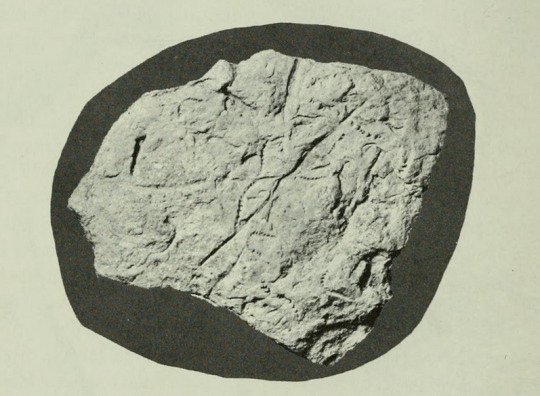
"Tracks of Pennsylvanian invertebrates as preserved in sandstone from West Texas."
From Fossils: An Introduction to Prehistoric Life (1962) by William Henry Matthews.
2 notes
·
View notes
Text
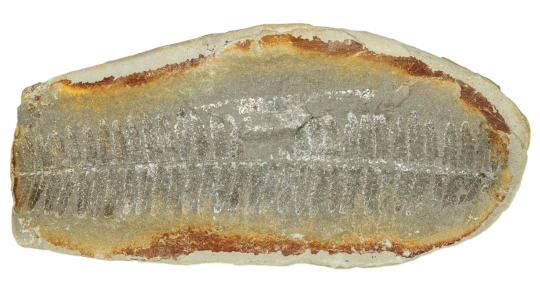
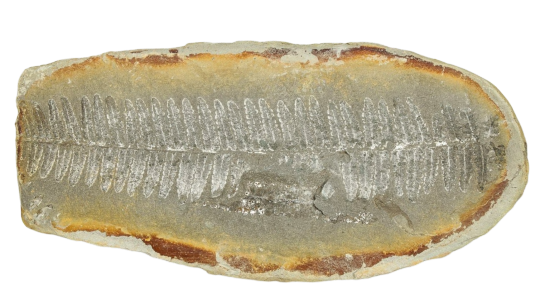
5" Fossil Fern (Pecopteris) Nodule Pos/Neg - Mazon Creek
#Pennsylvanian#pecopteris#fern#fern fossil#ferns#plant#plant fossil#pos/neg#fossil#fossils#prehistoric#png#transparent#paleontology#paleoblr
12 notes
·
View notes
Text
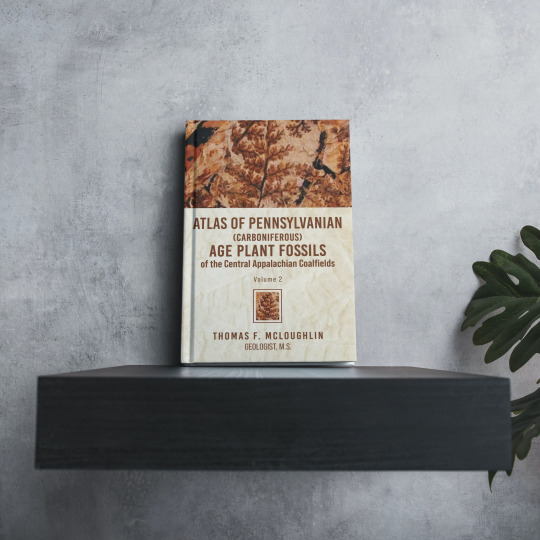
Atlas of Pennsylvanian (Carboniferous) Age Plant Fossils of the Central Appalachian Coalfields by Thomas F. McLoughlin
Join us on a journey through time and geography in "Atlas of Pennsylvanian (Carboniferous) Age Plant Fossils of the Central Appalachian Coalfields" by Thomas F. McLoughlin. This book is your ultimate guide to the fascinating world of prehistoric plant life and marine organisms that coexisted with them.
Unearth the past's secrets in vivid color and incredible detail. Grab a copy at www.tfmcloughlin.com.
#Thomas F. McLoughlin#Atlas of Pennsylvanian Age Fossils#ReadersMagnet#atlas#prehistoric plant life#marine organisms#Plant Fossils#Fossil Collectors#Amateur Paleontology#Paleobotany#Geology#Natural History
0 notes
Text
Tully Monsters!

The Tully Monster is the state fossil of Illinois. They were soft-bodied marine invertebrates with googly eyes on stalks and an absolutely bonkers claw-snoot that lived during the Pennsylvanian period, ~300 million years ago.
These weirdos were discovered in the Mazon Creek fossil beds in Illinois by a collector named Francis Tully in the 1950s and have been confusing people ever since. -- October 2022
3 notes
·
View notes
Text

Nicknamed the "Y animal" or "wye", Escumasia roryi is an enigmatic fossil organism known from the Late Carboniferous Mazon Creek fossil beds in Illinois, USA, dating to about 308 million years ago.
Growing up to around 15cm tall (~6") this strange soft-bodied creature was Y-shaped, with two slender "arms" on each side of an apparent mouth opening, a flattened sac-like body with another opening on one side, and a long stalk ending in an attachment disc. Some specimens have uneven arm lengths, which may indicate damage from predation.
Being only known from the exceptional preservation conditions of Mazon Creek, and with nothing else quite like it in the known fossil record, Escumasia's evolutionary relationships are still a mystery. It's been tentatively linked to cnidarians – but this doesn't really fit based on its anatomy, and little further study has been done on it since its discovery in the 1970s.
It was probably a filter feeder, living attached to the seafloor and capturing suspended organic material or small planktonic prey with its arms. The environment it inhabited was a shallow tropical marine bay, located close to the equator at the time, near a large river delta that would have made the surrounding waters rather brackish. This ecosystem was dominated by cnidarians, particularly the anemone Essexella, along with various arthropods, lobopodians, polychaete worms, molluscs, echinoderms, fish, lampreys, hagfish, and other difficult-to-classify weirdos like the famous "Tully monster" Tullimonstrum.
———
NixIllustration.com | Tumblr | Patreon
References:
Clements, Thomas, Mark Purnell, and Sarah Gabbott. "The Mazon Creek Lagerstätte: a diverse late Paleozoic ecosystem entombed within siderite concretions." Journal of the Geological Society 176.1 (2019): 1-11. https://doi.org/10.1144/jgs2018-088
Nitecki, Matthew H., and Alan Solem. "A problematic organism from the Mazon Creek (Pennsylvanian) of Illinois." Journal of Paleontology (1973): 903-907. https://www.jstor.org/stable/1303070
Wikipedia contributors. “Mazon Creek fossil beds.” Wikipedia, 10 May 2024, https://en.wikipedia.org/wiki/Mazon_Creek_fossil_beds
#science illustration#paleontology#paleoart#palaeoblr#escumasia#incertae sedis#problematica#animalia#art#y animal#wye#actual ancient aliens
191 notes
·
View notes
Text
Arianna's Notes – Speleonectes lucayensis — First Living Remipede in the World
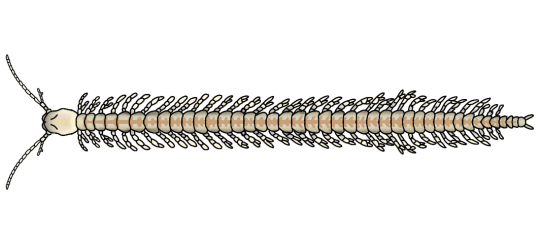
Speleonectes lucayensis is the species of living remipede, a new class of crustacean from a marine cave in the Bahamas. The first described remipede was the fossil Tesnusocaris goldichi (Lower Pennsylvanian) in 1955, while Speleonectes lucayensis was discovered as living species in 1981.
#ognimdo2002#earth responsibly#earth#art#ibispaint art#art ph#ibispaintx#wildlife#remipede#Speleonectes#Speleonectes lucayensis#bahamas#crustacean#crab#caribbean#venomous#holocene
0 notes